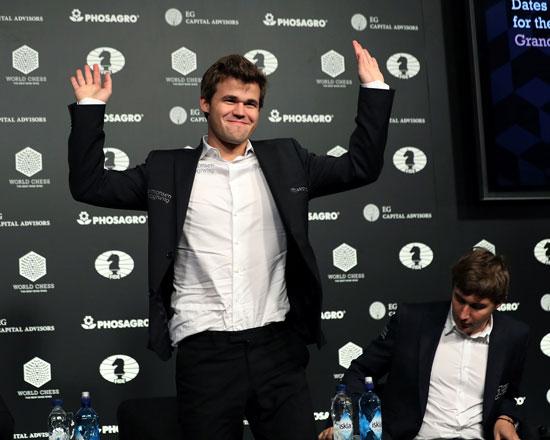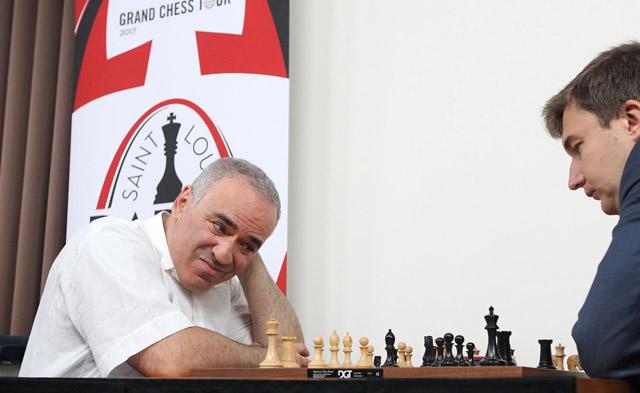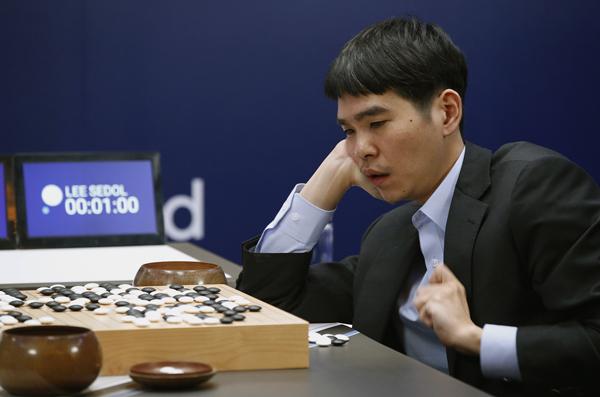You are here
Norwegian victorious again at World Chess Championship
By AP - Dec 01,2016 - Last updated at Dec 01,2016

World Chess Champion Magnus Carlsen of Norway waves to the crowd at a news conference after defeating Sergey Karjakin of Russia at the 2016 World Chess Championship match in New York on Wednesday (Reuters photo by Mark Kauzlarich)
NEW YORK — On a dreary, rainy Manhattan night, a huge, happy roar arose in a crowd of chess fans from around the world.
Two-time world chess champion, Magnus Carlsen, had just reached for a final, victorious move on Wednesday that crowned him a champ for the third time.
He marked his 26th birthday by beating Russian 26-year-old grandmaster Sergey Karjakin with bold, aggressive moves in a series of tiebreakers capping three weeks of the World Chess Championship that was tied after 12 games; 10 draws and one win each.
Carlsen used a queen sacrifice to checkmate his opponent.
The setting was a refurbished New York City building overlooking the Brooklyn Bridge that was once the city’s fish market.
On this night, it became a glittering gathering of hundreds of fans — adults and children — from Norway, Russia, the United States and elsewhere. They were riveted as the two grandmasters leaned into the tense game, barely moving, in total silence and deep in thought.
Fans paid $100 to enter, feasting on snacks and drinks as they kept their eyes glued to flat-screens that beamed close-ups of the chessboard in an inner chamber. A panel of soundproof glass shielded the players from onlookers, who could see in but whom the players could not see.
Hungarian grandmaster Judit Polgar said the four lightning-quick games played on Wednesday — plus even faster ones that was not needed — were “like Russian roulette”.
“Today, the faster games are a great show even for people who don’t know the game,” said Polgar, considered the greatest female player ever.
On Wednesday, the required mental strategies also played out on chessboards scattered around the spectator lounge. People hovered over them, trying out various combinations of pieces, mirroring the masters.
“Magnus is my hero because he takes risks, he’s really exciting,” said Pippa Millstone, a Manhattan 9-year-old who came to watch the tournament for her fourth time.
“The game is pretty even now, but I feel like Magnus is going to start attacking really soon,” she said in the middle of the third of the four so-called “rapid games,” each about a half-hour long, played as tiebreakers.
Carlsen and Karjakin reached a draw in two, and the Norwegian won two for the championship.
At crucial moments, spectators hushed, waiting to see what the next move would be. One whispered, “no, no” when Karjakin’s choice seemed halting, or on the defensive.
Even the winner missed a chance in one game, drawing groans and a few happy shrieks, depending on loyalties.
Organisers said about 6 million people around the world followed the last games — sort of like sudden death play in football.
Most fans were in homes and clubs across the globe. Some spent $15 for a pay-per-view live transmission, others to watch via high-tech goggles in 3-D virtual reality or by tracking moves on various free websites.
The prize was $1.1 million divided between the two players, with the winner getting 60 per cent.
The New York championship did not escape the shadow of East-West rivalry dating to the Cold War days when American Bobby Fischer beat Russian defender Boris Spassky in 1972.
This time, a key figure in chess was absent in New York: Kirsan Ilyumzhinov, a Russian multimillionaire and long-time president of the governing World Chess Federation who was accused by the US government of collaborating with the Syrian regime.
Related Articles
ST LOUIS — Twelve years after trading chess for politics, Garry Kasparov proved on Monday that time had not dulled his edge as he battled to
SEOUL — A champion Go player scored his first win over a Go-playing computer programme on Sunday after losing three straight times in the an
AMMAN — The stage is set for sport’s biggest night of the year — The Black Iris Sports Awards — taking place on Monday night The cream

















